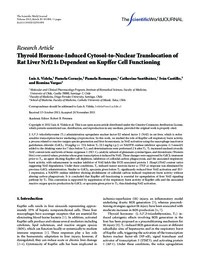Mostrar el registro sencillo de la publicación
Thyroid hormone-induced cytosol-to-nuclear translocation of rat liver Nrf2 is dependent on Kupffer cell functioning
| dc.contributor.author | Videla, Luis A. | |
| dc.contributor.author | Cornejo, Pamela | |
| dc.contributor.author | Romanque, Pamela | |
| dc.contributor.author | Santibáñez, Catherine | |
| dc.contributor.author | Castillo-Montecinos, Iván | |
| dc.contributor.author | Vargas, Romina | |
| dc.date.accessioned | 2017-11-24T15:15:26Z | |
| dc.date.available | 2017-11-24T15:15:26Z | |
| dc.date.issued | 2012 | |
| dc.identifier.uri | http://repositorio.ucm.cl/handle/ucm/1430 | |
| dc.description.abstract | L-3,3 ,5-triiodothyronine (T3) administration upregulates nuclear factor-E2-related factor 2 (Nrf2) in rat liver, which is redoxsensitive transcription factor mediating cytoprotection. In this work, we studied the role of Kupffer cell respiratory burst activity, a process related to reactive oxygen species generation and liver homeostasis, in Nrf2 activation using the macrophage inactivator gadolinium chloride (GdCl3; 10 mg/kg i.v. 72 h before T3 [0.1 mg/kg i.p.]) or NADPH oxidase inhibitor apocynin (1.5 mmol/L added to the drinking water for 7 days before T3), and determinations were performed 2 h after T3. T3 increased nuclear/cytosolic Nrf2 content ratio and levels of heme oxygenase 1 (HO-1), catalytic subunit of glutamate cysteine ligase, and thioredoxin (Western blot) over control values, proteins whose gene transcription is induced by Nrf2. These changes were suppressed by GdCl3 treatment prior to T3, an agent-eliciting Kupffer-cell depletion, inhibition of colloidal carbon phagocytosis, and the associated respiratory burst activity, with enhancement in nuclear inhibitor of Nrf2 kelch-like ECH-associated protein 1 (Keap1)/Nrf2 content ratios suggesting Nrf2 degradation. Under these conditions, T3-induced tumor necrosis factor-α (TNF-α) response was eliminated by previous GdCl3 administration. Similar to GdCl3, apocynin given before T3 significantly reduced liver Nrf2 activation and HO- 1 expression, a NADPH oxidase inhibitor eliciting abolishment of colloidal carbon-induced respiratory burst activity with out altering carbon phagocytosis. It is concluded that Kupffer cell functioning is essential for upregulation of liver Nrf2-signaling pathway by T3. This contention is supported by suppression of the respiratory burst activity of Kupffer cells and the associated reactive oxygen species production by GdCl3 or apocynin given prior to T3, thus hindering Nrf2 activation. | es_CL |
| dc.language.iso | en | es_CL |
| dc.rights | Atribución-NoComercial-SinDerivadas 3.0 Chile | * |
| dc.rights.uri | http://creativecommons.org/licenses/by-nc-nd/3.0/cl/ | * |
| dc.source | The Scientific World Journal, 2012, 301494 | es_CL |
| dc.title | Thyroid hormone-induced cytosol-to-nuclear translocation of rat liver Nrf2 is dependent on Kupffer cell functioning | es_CL |
| dc.type | Article | es_CL |
| dc.ucm.facultad | Facultad de Medicina | es_CL |
| dc.ucm.indexacion | Scopus | es_CL |
| dc.ucm.indexacion | Isi | es_CL |
| dc.ucm.doi | dx.doi.org/10.1100/2012/301494 | es_CL |



